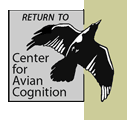


| Content Pages | ||
|
Spatial Memory Use of Landmarks |
||
|
|
||
| People | ||
| Russell P. Balda | ||
| Alan C. Kamil | ||
|
|
||
| Docs & Links | ||
|
Books Publications Links |
||
|
|
||
 |
||
 |
||
 |
How
Nutcrackers Use Landmarks
We first undertook a series of experiments in which the birds were trained to find food at a location specified by its spatial relationship to a set of landmarks. This procedure offered the advantage of precise experimental control over the placement of the goal, that is, the location that the bird had to remember. Some of our earliest work on this topic was conducted by Kristy Gould-Beierle (Gould-Beierle & Kamil 1998, 1999), using procedures developed by Cheng and Sherry (1992). In these experiments, nutcrackers were trained to find a goal whose location was defined by local cues (a vertical PVC landmark and a long, straight-edged board) and global cues (features of the walls and ceiling), and the interaction of local and global cues was examined. One important finding of this work was that when local cues were positioned farther from the goal, global cues had more influence on search behavior.
The psychological mechanism involved in the interaction between the goal and the cues was examined more closely by Leida Goodyear in her work on spatial overshadowing (Goodyear & Kamil 2004). Previous studies had shown that when a location was learned relative to a number of local landmarks, the closest landmark exercised the greatest control over searching behavior, in a manner analogous to overshadowing in Pavlovian conditioning. Goodyear manipulated the distance between a goal and a landmark array systematically (modifying an approach used by Spetch and colleagues with pigeons searching on a computer monitor). She found that overshadowing decreased rapidly as the distance between the goal and the nearest landmark increased. Jody Lewis followed this up with a study of the roles of proactive and retroactive interference on spatial memory in nutcrackers. In this work, she used an open-room design with seeds buried in sand-filled cups, testing nutcrackers for their memory for each location in a memory list. She found that the birds made errors by visiting the interfering list of locations during recovery of the target list, demonstrating that they were susceptible to proactive and retroactive interference during the recall of spatial information (Lewis & Kamil 2006).
Juli Jones and Al Kamil then looked at the perceptual code that nutcrackers use to remember a location, establishing that the birds could learn an abstract geometric definition of a location, such as "halfway between two landmarks" (Kamil & Jones 1997, 2000), and that they could do so even when those landmarks rotated during training (Jones & Kamil 2001). These experiments established that when given appropriate training, nutcrackers could encode a location in terms general enough to permit accurate search when the position of the landmarks was changed, but the geometric relationship between the landmarks and the goal was maintained. The nature of the training had strong effects on the flexibility of the code, however. Nutcrackers in a four-landmark experiment were given tests that expanded the array in the east-west direction, the north-south direction, or in both directions simultaneously. Although the birds learned to search accurately at the center of the landmark array during training, this search pattern did not transfer to the expansion tests (Kelly, et al. 2008).
To begin to integrate these psychological findings, Al Kamil, working with Ken Cheng of MacQuarie University in Australia, developed a new hypothesis to explain how nutcrackers use arrays of multiple landmarks to re-locate a position in space. They termed it the "multiple-bearings hypothesis" (Kamil & Cheng, 2001). Preliminary tests of the hypothesis were encouraging (Kamil, Goodyear & Cheng, 2001), but more rigorous testing in a circular experimental chamber showed that the cognitive process involved in location judgment was exceedingly complex and multi-layered. As the distance between the goal and the landmark increased, nutcrackers were less accurate at finding the correct direction to the goal than they were at estimating the distance (Expt 1). To further examine how the birds were calculating direction, the featural cues within the environment were rotated by 90° and the birds were either oriented when searching (Expts 2 and 3) or disoriented (Expt 3). In Expt 4, all distinctive visual cues were removed (both internal and external to the environment), a novel point of entry was used, and the birds were either oriented or disoriented. We found that disorienting the nutcrackers so that they could not use inertial cues did not influence the birds' total search error. The birds relied heavily but not completely on cues within the environment, as rotating available cues caused them to systematically shift their search behavior. In addition, the birds also relied to some extent on Earth-based cues. These results show the flexible nature of cue use by the Clark's nutcracker and indicate that multiple sources of spatial information may be necessary for extracting multiple navigation bearings (Kelly, Kamil & Cheng 2010).
Funding for this work at the Center for Avian Cognition finally ended in 2008, though research on spatial cognition in nutcrackers continues at several other laboratories, including those of Debbie Kelly at the University of Manitoba, Brett Gibson at the University of New Hampshire, and Kristie Gould at Luther College, Iowa.
References from Other Sources
Cheng, K., & Sherry, D.F. (1992). Landmark-based spatial memory in birds (Parus atricapillus and Columba livia): The use of edges and distances to represent spatial positions. Journal of Comparative Psychology, 106: 331-334.
Gould-Beierle, K. L., & Kamil, A. C. (1998). Use of landmarks in three species of food-storing corvids. Ethology, 104(5): 361-377.